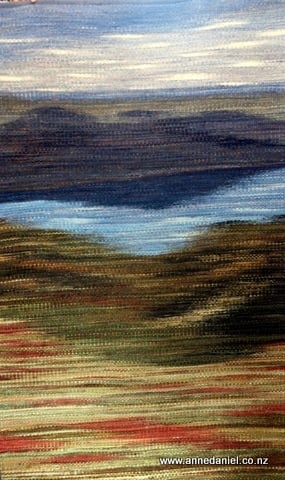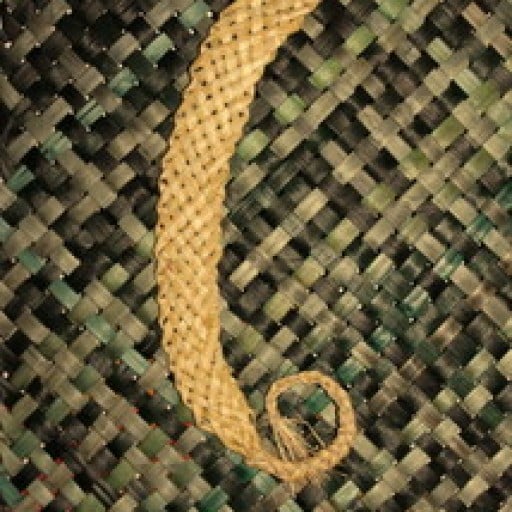I use a range of materials in my creations. When doing raranga, basket making and papermaking I predominantly use natural materials, many from my immediate environment. On the loom, I mainly use wool but also some synthetic materials. Some projects involve the use of found objects and recycled materials, including paper, plastic, metals and wood.
Plant materials
- Harakeke
Harakeke growing in the pā harakeke in my garden
Harakeke (New Zealand flax – Phormium spp.) is a plant native to New Zealand and although commonly known as flax, it is from the lily rather than flax family. There are two species found here Phormium tenax and Phormium cookianum. The leaves of Phormium tenax are longer and stronger than Phormium cookianum, and are usually used for weaving. It is the most widely used native plant both in traditional and contemporary Māori weaving.
Landcare Research – Manaaki Whenua – at Lincoln, near Christchurch is kaitiaki (guardian) of a collection of traditional weaving varieties of harakeke (NZ flax, Phormium spp.) donated by Rene Orchiston of Gisborne. This is known as the National New Zealand Flax Collection. There are over 50 named varieties which have different qualities and strengths. There are varieties specially suited to making kete, whāriki, piupiu and cloaks.
Woven disc in dyed harakeke
I have 17 different varieties from this collection growing in the pā harakeke in my garden and some of the unnamed varieties that grow profusely on the West Coast. Most of the harakeke I use in my weaving, basket making and papermaking is harvested from my garden. I have a made a catalogue of samples of each variety prepared in different ways so that before embarking on a project, I can decide which bush I will harvest from.
The harvested harakeke is prepared in different ways depending on what I am creating. I may use whole leaves, or split them into narrower strips or shredded them or extract the silky fibre – muka – from them. Then I may use the prepared material in this state, or soften it, boil it or dye it. For dyeing I use Teri phormalan dyes.
-
Ti kouka used in base of coiled pine needle pot
Tī kōuka (cabbage tree – cordyline australis)
This tree is quite distinctive in the New Zealand landscape. I have used the leaves green to make kete but I also collect the dead leaves off the ground below the tree and use them in basket making.
- Kuta (Bamboo spike sedge – Eleocharis sphacelata)
- Small kuta mat
This is a sedge that grows around swamps, ponds and shallow lakes. The long stems (culms) are cylindrical with air pockets. When harvested, flattened and dried, the stems make excellent weaving material, being softer than harakeke. While bright green in the water the finished items can be quite stunning with the range of gold through brown colours. I have woven whariki, a rain cape and small mats using kuta.
Kareao (Supplejack – Ripogonum scandens)
- Basket woven out of kareao/supplejack
This vine grows prolifically in the bush on my property and I plan to make much more use of it in my creations.

- Supplejack egg
- Nikau sail
- Nikau (Rhopalostylis sapida)
Nikau is a palm endemic to New Zealand.
- Pine needles (Pinus spp.)
Pine Needle pot
I am constantly on the lookout for pine trees with long needles for basket making – not the common radiata pine which are too thin and short to be of use.
- Wool and other yarns

From Mount Tuhua
I acquired a large stash of weaving yarns when I purchased my floor loom. Most was wool but I often find myself trying to establish the composition of a yarn using flame tests before beginning a weaving project.
I also acquired a large amount of sheep wool in its raw state from my father. He used to spin and work in shearing sheds and over the years collected good fleeces. Although I now have his spinning wheel, I haven’t found the time for advancing much on this yet. I used a large amount of carded wool which I dyed in weaving the rug From Mount Tuhua and wall hanging.
Recycled Materials
- Plastic
Wrap Dup – HokitikaJunk2Funk2014
My works in plastic have been for up-cycling/recycling based exhibitions. I do not particularly enjoy weaving in this medium – it is much more difficult to handle and lacks soul. I have used such things as plastic strapping tape (used around boxes, also in building), long narrow plastic bags that the newspaper is delivered in, plastic supermarket bags and used audio tapes.
- Paper
Unravelled News – HokitikaJunk2Funk2011
Newspaper formed the main basis of a cloak Unravelled News woven on the loom with a warp in wool unravelled from a previously knitted garment.

